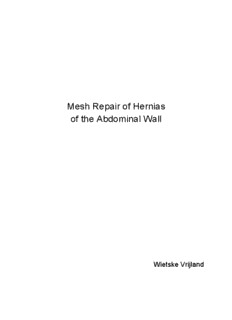
Mesh Repair of Hernias of the Abdominal Wall - RePub - Erasmus PDF
Preview Mesh Repair of Hernias of the Abdominal Wall - RePub - Erasmus
Mesh Repair of Hernias of the Abdominal Wall Wietske Vrijland €ducost Publishers Cover design: Sacha Hart-Schellart Printpartners Ipskamp B.V., Enschede © W.W. Vrijland, Rotterdam, 2003 No part of this book may be reproduced by print, xerography or any other means without the authors permission in writing. ISBN 90-9016661-0 ii Mesh repair of hernias of the abdominal wall Correctie van buikwandhernia’s met kunststof materiaal Proefschrift ter verkrijging van de graad van doctor aan de Erasmus Universiteit Rotterdam op gezag van de Rector Magnificus Prof.dr.ir. J.H. van Bemmel en volgens besluit van het College voor Promoties. De openbare verdediging zal plaatsvinden op woensdag 19 maart 2003 om 15:45 uur door Wietske Willemijn Vrijland geboren te Enschede iii Promotiecommissie Promotoren: Prof.dr. J. Jeekel Prof.dr. H.J. Bonjer Overige leden: Prof.dr. Th.J.M. Helmerhorst Prof.dr. H.W. Tilanus Prof.dr. J.B.M.Z. Trimbos iv CONTENTS 1 General Introduction 1 2 Randomized Clinical Trial of Non-Mesh versus Mesh Repair of Primary Inguinal Hernia 17 3 Prosthetic Mesh Repair should be Used for Any Defect in the Abdominal Wall 27 4 Introduction to Pathophysiology and Prevention of Postoperative Adhesions 31 5 Peritoneal Adhesions to Prosthetic Materials: Choice of Mesh for Incisional Hernia Repair 35 6 Intraperitoneal Polypropylene Mesh Repair of Incisional Hernia is not Associated with Entercutaneous Fistula 43 7 Fewer Intraperitoneal Adhesions with Use of Hyaluronic Acid- Carboxymethylcellulose Membrane; A Randomized Clinical Trial 51 8 Abdominal Adhesions: Intestinal Obstruction, Pain and Infertility 65 9 Discussion 75 Summary 81 Conclusions 83 Samenvatting 85 List of Publications 88 References 89 Dankwoord 101 Curriculum Vitae 105 v vi Introduction CHAPTER 1 GENERAL INTRODUCTION 1 Chapter 1 2 Introduction 1.1 Overview of the thesis Hernia of the ventral abdominal wall A hernia of the abdominal wall is a permanent or intermittent protrusion of abdominal contents outside the abdominal cavity through a defect in the abdominal wall. Approximately 75% of all hernias occur in the inguinal region. Other types of hernias of the ventral abdominal wall are incisional, umbilical, epigastric and Spigelian hernia. In chapter 1 an overview of hernias of the abdominal wall is described. The incidence, clinical implications and treatment options and their complications are described, based on the available literature regarding this subject. Since there are numerous methods for abdominal wall hernia repair, without consensus about the preferred method, we decided to perform a randomized clinical trial to compare mesh and non-mesh repair for inguinal hernias. This randomized clinical trial is described in chapter 2. The preferential method of hernia repair is discussed in an editorial, not only for inguinal hernias, but also for other types of abdominal wall hernias such as incisional hernias and large umbilical hernias. Endoscopic hernia repair was included in this editorial, which is described in chapter 3. Complications of mesh repair of abdominal wall hernias Ideally, prosthetic mesh is placed preperitoneally. If the mesh can be placed between the abdominal wall and peritoneum or prefascially, opening of the abdominal cavity can be avoided and the peritoneum and the abdominal contents are not exposed to injury. For uncomplicated inguinal hernias prefascial or preperitoneal placement of mesh is easy to perform, but for incisional and recurrent umbilical hernias intraperitoneal placement of mesh is often unavoidable. Possible complications of intraperitoneal mesh placement are adhesions and entero- cutaneous fistulas. Adhesions developing after abdominal surgery are abnormal attachments between tissues and organs. The formation of adhesions results from peritoneal laceration and is enhanced by the presence of foreign materials in the abdominal cavity such as sutures and prosthetic mesh. An introduction to postoperative adhesion formation is described in chapter 4. An animal study on the formation of adhesions in the presence of a non-absorbable mesh which is often used in hernia repair is described in chapter 5. This mesh is applied with and without coverage by an absorbable mesh, which was suggested to prevent the formation of adhesions. A newly developed mesh with an inert surface was also tested. Enterocutaneous fistulas are a feared complication after intraabdominal mesh placement because their morbidity is severe and repair technically difficult. Although only few enterocutaneous fistulas have been reported in literature, the common opinion is that polypropylene mesh should never be in contact with intraabdominal organs to avoid this complication [Morris-Stiff 1998]. In chapter 6 a retrospective analysis of the outcome of incisional hernia repair with polypropylene mesh is described to assess the risk of enterocutaneous fistula formation, combined with an overview of literature concerning this topic. 3 Chapter 1 Prevention and treatment of postoperative complications related to adhesions To prevent the formation of adhesions, it was suggested that a mechanical barrier could be used peroperatively to temporarily separate the intraabdominal viscera from the abdominal wall or prosthetic mesh. A membrane containing hyaluronic acid has been developed for this purpose, which already has been shown effective in experimental studies. To assess the value of this material in clinical circumstances, a randomized controlled multicenter study was performed which is described in chapter 7. Surgery is the only modality to confirm the presence of adhesions in the abdominal cavity and surgical lysis is the only therapy available. The reported results of adhesiolysis vary widely, and studies cannot be compared because the indication for adhesiolysis and duration of follow-up differ. In Chapter 8 the indication, method and success rate of adhesiolysis for intestinal obstruction, chronic abdominal pain and infertility are reviewed. Chapter 9 contains the general discussion of this thesis. 4
Description: